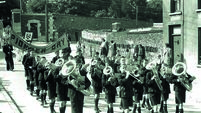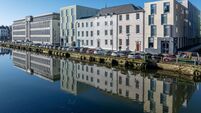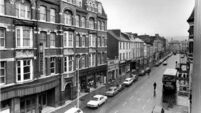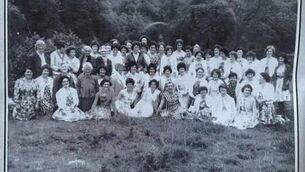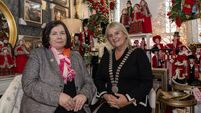Throwback Thursday: When you stored your bike in a Cork city cycle park
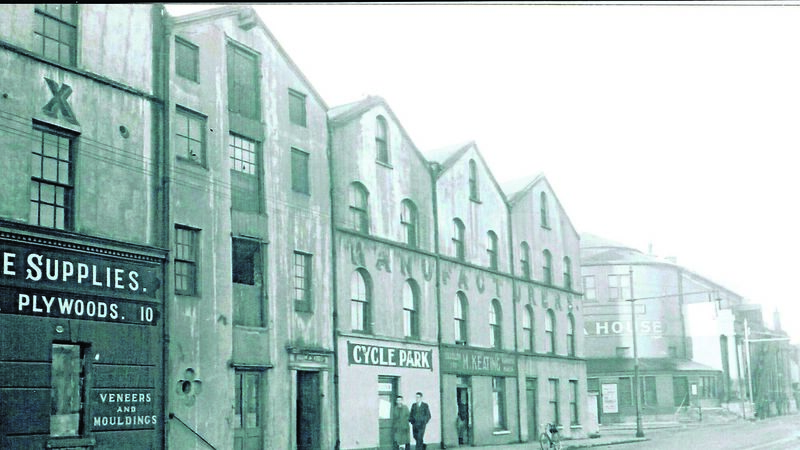
Mulcahy Brothers’ Cycle Park in Lavitts Quay, Cork city, from the Day Collection, supplied by Kevin Long. You can just see the old Opera House on the right.
WE certainly seem to have unlocked a whole treasure chest of memories with our features in Throwback Thursday on De Glen.
The stories keep rolling in, with great recollections of happy childhood days in this Cork city wonderland. One such account came from Noel Dillon:
“It was nostalgic and very informative to read the history of the Glen going back many decades. It was the playground of my youth, and of all my friends.”
While, naturally, Noel was aware of the Goulding’s factory, he says he was not aware that there were once six factories in production there. But old friends live long in his memory.
“The aforementioned Tim Cramer was a schoolmate and good friend of mine. His mother, a lovely lady, worked in the Palace Cinema and would sometimes give Tim and myself two complimentary tickets for a film. Tim and I would play with two girls, neighbours of Tim - Norma Frackelton and Pauline Tilson - on summer evenings. We were only children!
“Later in life, when I worked in the Royal Insurance Company, I got to know another of Tim’s neighbours - Joan Woodward. She was pretty but promised, and left to get married soon after. Later in life, another of Tim’s neighbours - Mary O’Brien - came to work in the Royal. No wonder Tim always had a smile on his face living near a bevy of beauties!”
Reading of the factory lassies singing as they walked down through the Glen to the Sunbeam factory in Blackpool, Noel tells us that his sister, Audrey, would have been one of those very girls.
“It was there she met her husband Jack when he called to do an audit.”
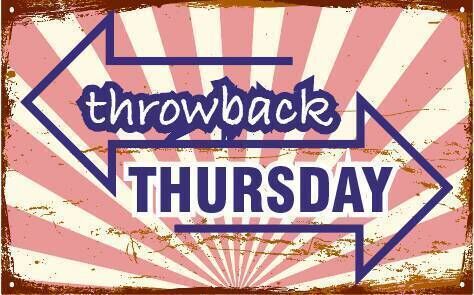
And Noel himself was one of those urchins who fished for thorneens and brought them home in a jam pot, as did Tim Cagney’s friend, Paddy, whose exploits were recorded recently.
“Unfortunately, I had not the skills of Paddy, and my thorneens did not live very long.”
On either side of Professor Aloys Fleischmann’s house, recalls Noel, were two small dairy farmers.
“The one near the Ballyvolane Road was a Mr Rice. It was believed among us kids that he was once a cowboy. In any case, I did see him ride his horse into the Glen and lasso one of his cows which had lost its footing on boggy ground following several days of continuous rain, and drag it out onto solid ground!
“When you crossed the stream over a rickety bridge, you arrived at the farm of Dan Murphy - the father of Tony Murphy of ‘Gay Future’ horse racing fame. Us youths would walk through the farmyard onto the Banduff Road where one could get good value for a penny in Mary Hayes’ sweetshop.
Noel adds: “Down beyond the engineer’s house, the stream was dammed and the water was about three feet deep. One could swim there if one dared. I did!
“The Black Patch, a grass-free area, was a great playground for us budding hurlers. On the right of this was a grass area where some adults dug small holes and played pitch and putt. One of these, I remember, was Mr Kelly whose family owned a small grocery shop in Dillon’s Cross. He was the father of the famous Fr Joe Kelly who ministered in New Zealand. Joe played hurling for Cork and was a great runner. He was believed to run the 100 yards in ten seconds when at college in Farranferris. When Fr Joe was home on holidays one year, he brought a bunch of hurleys back to New Zealand to teach the locals our great game!
“Those were the days, my friend, we thought they’d never end...”
Well, Noel, aren’t you the great man for sharing your wonderful memories. You’re an example to the rest of us. Anyone else with such rosy recollections of carefree childhood days, don’t keep them to yourself - let others enjoy them too on Throwback Thursday!
Incidentally, have you ever noticed the tall ventilation shafts rising suddenly from the ground in the Glen? They mark the subterranean railway tunnel that was built between 1847 and 1855 to connect Mallow station to that at Cork. Back then, of course, the Cork station was at Kilbarry - it took a bit longer to dig the tunnel which today takes the train right through to Glanmire and Kent Station. Well, it was to the station at Penrose Quay originally, but the volume of traffic soon demanded a new terminus at Glanmire, and the old Penrose Quay station became a cattle loading centre for the Innisfallen and other shipping that brought our much needed supplies to less favoured neighbouring countries.

Michael English, a well known Cork photographer, also has good memories of both the Glen and the main industry that gave it its name.
“Reading about Goulding’s Glen last week reminded me of the good times we had accompanying the firm’s pensioners on social trips to West Cork and other scenic areas, or for social evenings at the Goulding’s Sports and Social Club on the Boreenmanna Road, where Rockboro School now resides.
“I’ve attached a couple of photos which may be of interest. I can’t remember all the names but other readers may be able to do so. Most of them would have been from Blackpool and Dublin Hill areas. I worked there for 20 years (one at the Glen and the rest at the Marina), the last five or six in personnel, so I used to do photos for the company newsletter. There were some great characters there and some fine singers of all the old songs.”
Right, up to you now, avid readers of Throwback Thursday! Anybody in there that you can recognise? Make sure to let us know.

Now to the topic of cycling, Cork’s most popular way of getting around in the days before cars were owned even by teenagers.
Kevin Long wrote to tell us of a special Cork cycling exhibition held at the City Library on May 13 (the information arrived too late, alas, for inclusion in the previous Thursday’s page). Among the items in the exhibition were many wonderful old images of earlier days in the city when everyone went everywhere by bike.
“I want to say thanks for the Throwback Thursday articles in the Echo, they are a fantastic insight into the past,” writes Kevin. “I’m mailing because in the last year or so I’ve become involved with the Cork Cycling Campaign and love to see all the references to cycling in these articles. The photo exhibition which we held as part of Bike Week generated a lot of questions and discussion on the day about cycle parks in Cork.
"Some people who came to the event mentioned that their parents had often spoken of parking their bikes in such parks around town.
“Here is a photo shown at the exhibition, courtesy of Amy Ramsden, from the Alec Day collection, showing Mulcahy Bros cycle park on Lavitts Quay. The old Opera House can be seen in the background. I also found an advert in the Cork City & County Club Guide from 1948; Ross & Co on Winthrop Street was the largest cycle park in Ireland at the time.”
This topic was in fact aired on these pages a year or so ago, and it’s a fascinating one. Is there more information on these convenient and safe places to leave your bicycle during the day while you were at work?
“A project we are hoping to get done for Cork is a history of urban cycling over the past century, says Kevin.
“I’ve been in touch with the publishers of the Cycling Cities series, www.cyclingcities.info, and they have agreed to undertake a Cork book.
“Can I ask Throwback Thursday readers if they could share any information or stories about the cycle parks of our city? Any insight would be greatly appreciated and they could email info@corkcyclingcampaign.com.
Right, there’s another job for you, Throwback Thursday readers. Rack your brains, ask your parents, get the information to us, and to Kevin Long too!
Now let’s finish off with a sweet reminder, courtesy of Tim Cagney.
“You remember sherbet, don’t you? Paper packets of edible talcum-powder, complete with lollipops made of toffee or jelly. You moistened the lolly with your tongue, then dipped it in the sherbet, to transfer it to your mouth. Very sweet flavour - quite a delight to the childhood palette!
“Once the powder was gone, you could then eat what remained of the lolly. There was a variation, called ‘summer drinks’, where you emptied the powder into water to make a kind of lemonade, but let’s concentrate on the sherbet, for now.
“About three weeks ago, my wife and I decided to visit Sligo. We had never been, mainly because we had spent 50 years driving up and down to Kerry and Cork, visiting our respective parental homes. We always promised ourselves that, as soon as we became free of such obligations, we would explore the rest of Ireland, hence Sligo.
“It turned out to be a delightful place. Lots of good-quality roads, virtually traffic-free, making it very easy to visit all the local tourist attractions. To top it all, we got three days of sunshine!
"The day before we left Sligo, I called in to a filling-station, just across the road from our hotel. As I waited to pay for my diesel, I spotted sherbet on a shelf, beside the till. Not like the sherbet I used to know, however - this stuff was in a can, about the size of those small tins of tonic-water.
“I hadn’t seen sherbet since childhood, so - full of curiosity - I had to buy it. I wondered if they had devised a new way of consuming it (no lollipop) so, as soon as I got it home, I took a peek at the script on the can. No helpful information there, unfortunately, but what I DID notice was a reference to a colouring-matter called Allura Red. This substance, apparently, can have ‘an adverse effect on attention and activity in children’.
“I wondered at the ethics of actually selling this product, until my wife pointed out that many concoctions these days contain agents which can lead to hyper-activity in children.
“Nothing like that in our day, of course - or was there? Perhaps, way back then, they simply weren’t obliged to tell us?”
Yes, Tim, you do wonder just how many of the sweets we eagerly consumed back in the day contained questionable or damaging ingredients. And hey - maybe that’s why they don’t taste like they used to?
Healthier, doubtless, and conforming to modern rulings, but...? Let’s hear your views on this taxing topic.
Email jokerrigan1@gmail.com with your memories, or leave a comment on our Facebook page: https://www.facebook.com/echolivecork.
